Korean Braised Tofu – Dubu-Jorim | 두부조림
By Lee Jackson ↣ Published on: July 16, 2021
Discover the delights of Dubu Jorim, a traditional Korean dish where tofu is gently braised in a rich, flavourful sauce of soy, garlic, and spices. My quick and easy recipe offers a perfect harmony of savoury and satisfying flavours.
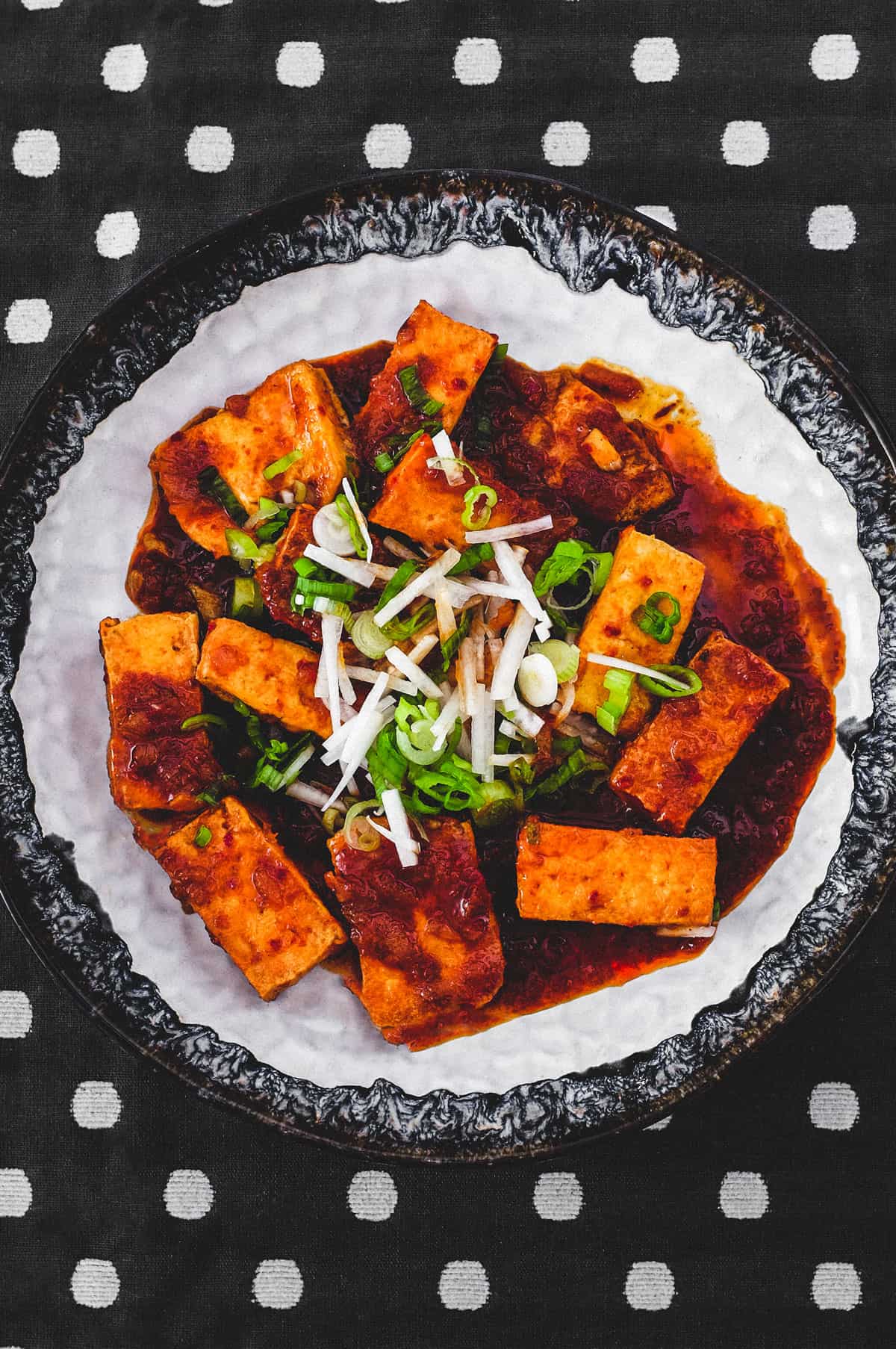
When it comes to tasty Korean banchan, there are few flavours more intoxicating than dubu jorim - a Korean tofu recipe like no other. Deliciously soft tofu is fried to form a crisp exterior, while the inside remains soft and decadent. It's then lightly braised in a vibrant and flavourful chilli sauce - the tofu soaks up the sauce and creates a fantastic combination of flavour and texture.
It's a great dish to eat in many ways - my favourite way is to simply have it over rice with as a rice bowl with some kimchi on the side. A fried egg on to never hurt anyone too! It's also great as a side dish served alongside other small plates (banchan) as a larger Korean feast.
This dubu jorim recipe is one of my favourite Korean tofu recipes, in fact one of my favourite tofu recipes period!
What's Ahead?
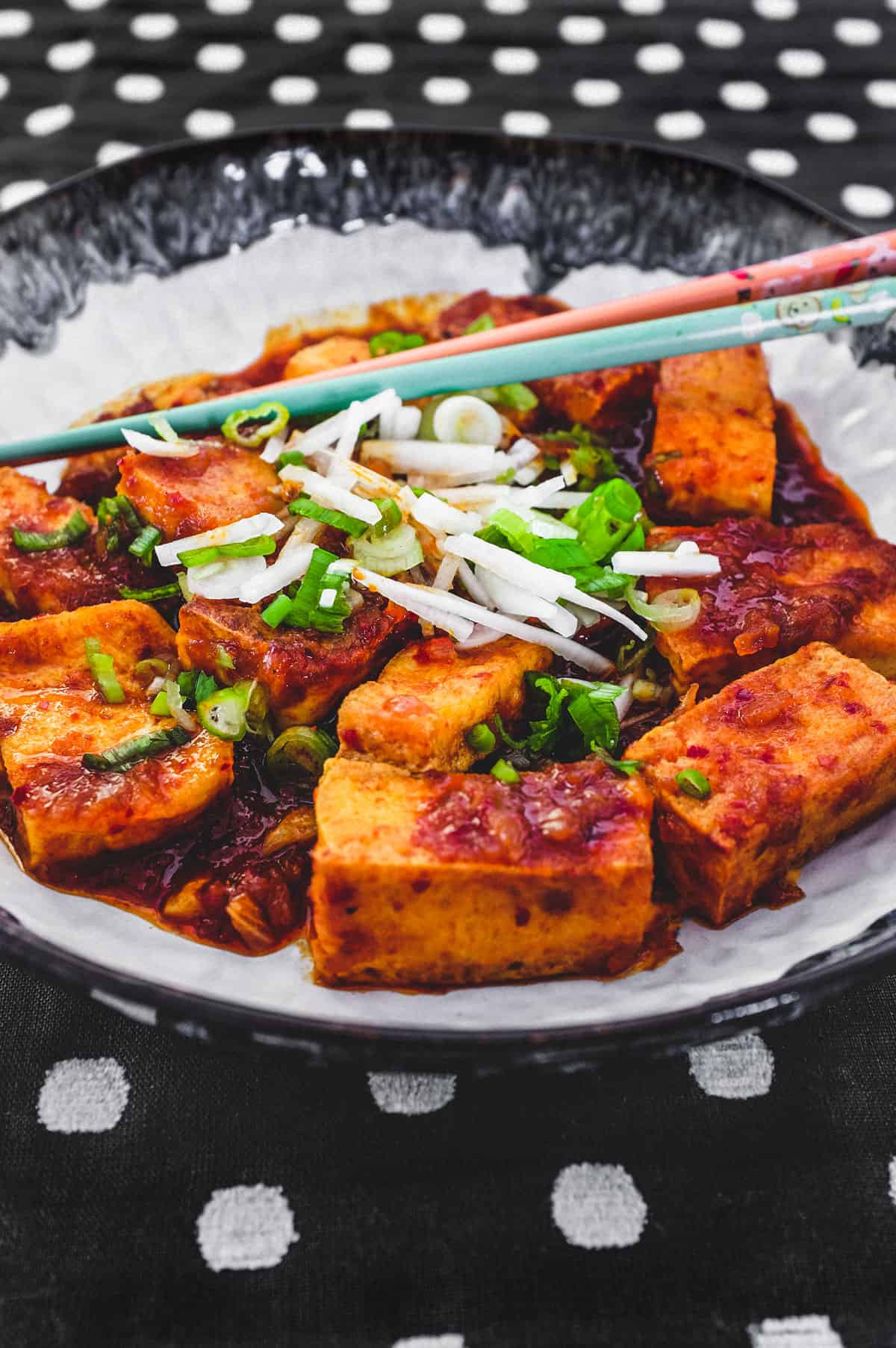
What is Dubu Jorim?
In Korean, "dubu" (두부) refers to tofu, and "jorim" (조림) means 'braised'.
It's a traditional Korean dish made with tofu that has been gently braised in a savoury, flavourful sauce. The tofu is typically cut into cubes or slices and simmered in a mixture of soy sauce, garlic, sesame oil, sugar, and other seasonings until it absorbs the rich flavours of the sauce. Sometimes, additional ingredients such as vegetables or meat may be added to enhance the dish. Dubu Jorim is known for its delicious balance of textures and savoury taste, making it a popular banchan (side dish) in Korean.
Why it works?
Flavour all the way! - dubu-jorim is packed with an amazing amount of umami, spicy flavour that never fails to disappoint. As a secondary bonus, it's pretty healthy too!
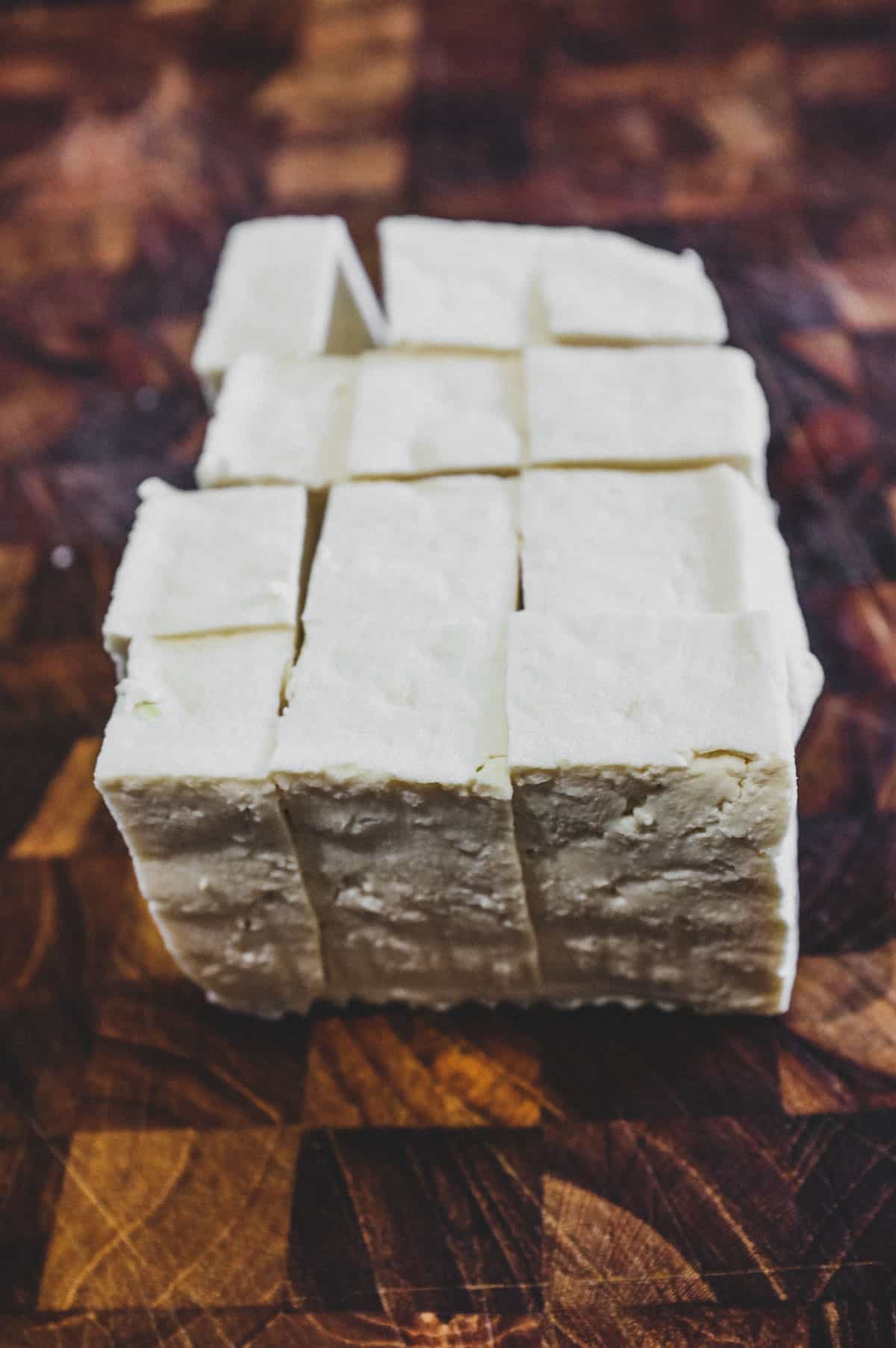
Stuff You'll Need
Making dubu jorim is actually very easy, so let's see what makes the magic happen. There's a full recipe below, but these are the key ingredients.
- Tofu - the best tofu to use for dubu jorim is 'Firm'. It will hold its shape during frying and form a wonderful crisp exterior while retaining a soft, melting interior. Quite the combination!
- Sesame oil - one of the key flavours to Korean food, sesame oil is essential - bringing it's nutty and intoxicating aroma.
- Gochujang Sauce - Korea's much loved chilli sauce is available in paste form which is thick and sticky or in a sauce in a squeezy bottle. You can use either.
- Gochugaru - These ubiquitous mild chilli flakes help creates the pillar-box red colour of many Korean dishes.
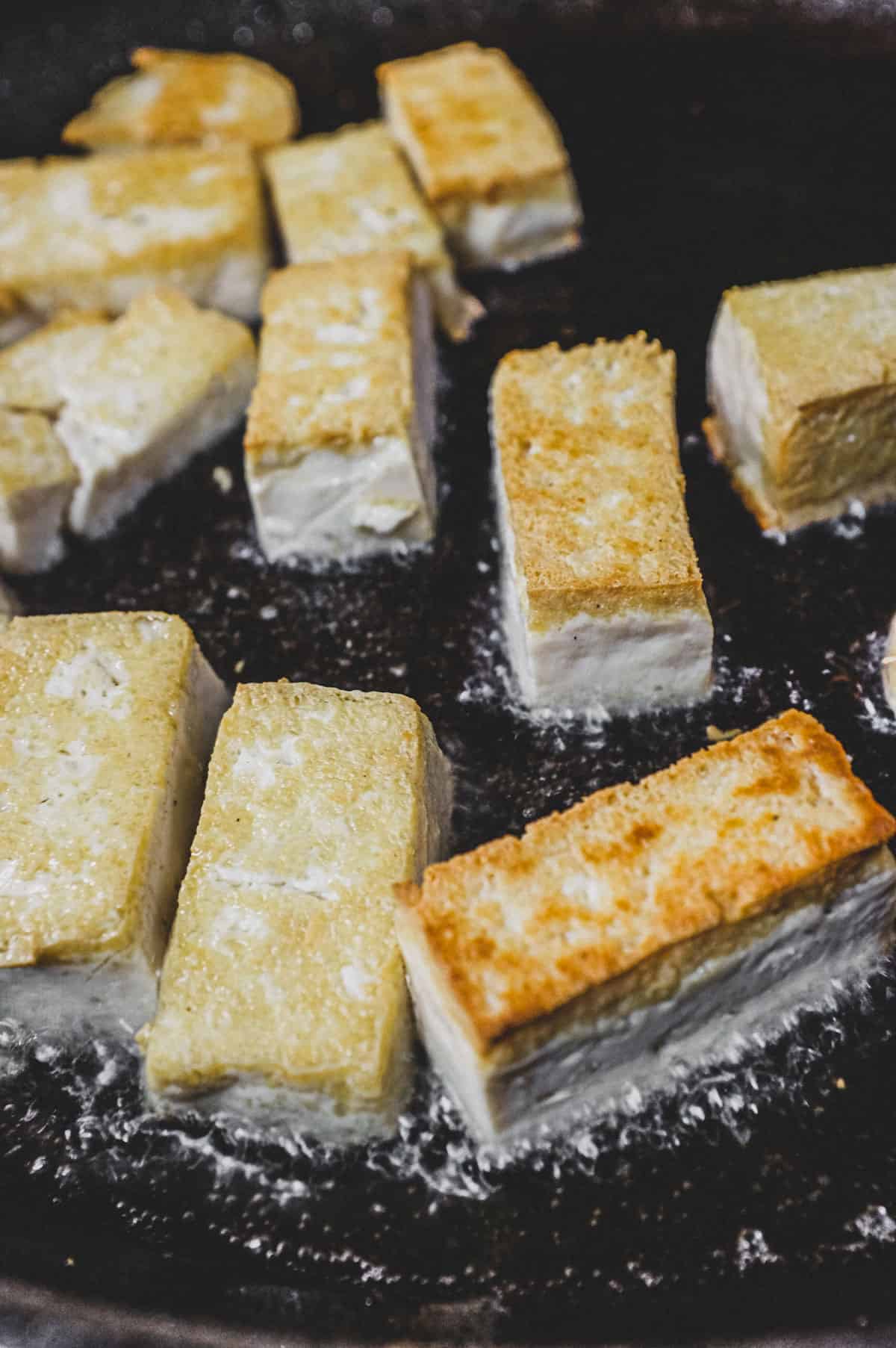
Step by Step
Creating this braised tofu is really not difficult. There are only three simple steps to success:
- Fry the tofu - divide into cubes or slices and fry for 7 minutes each side to create a crisp exterior.
- Create the sauce - fry up some onion and garlic and add the gochugaru, sugar, sesame, soy and water and sizzle for a minute.
- Toss the tofu in the sauce and that's it!
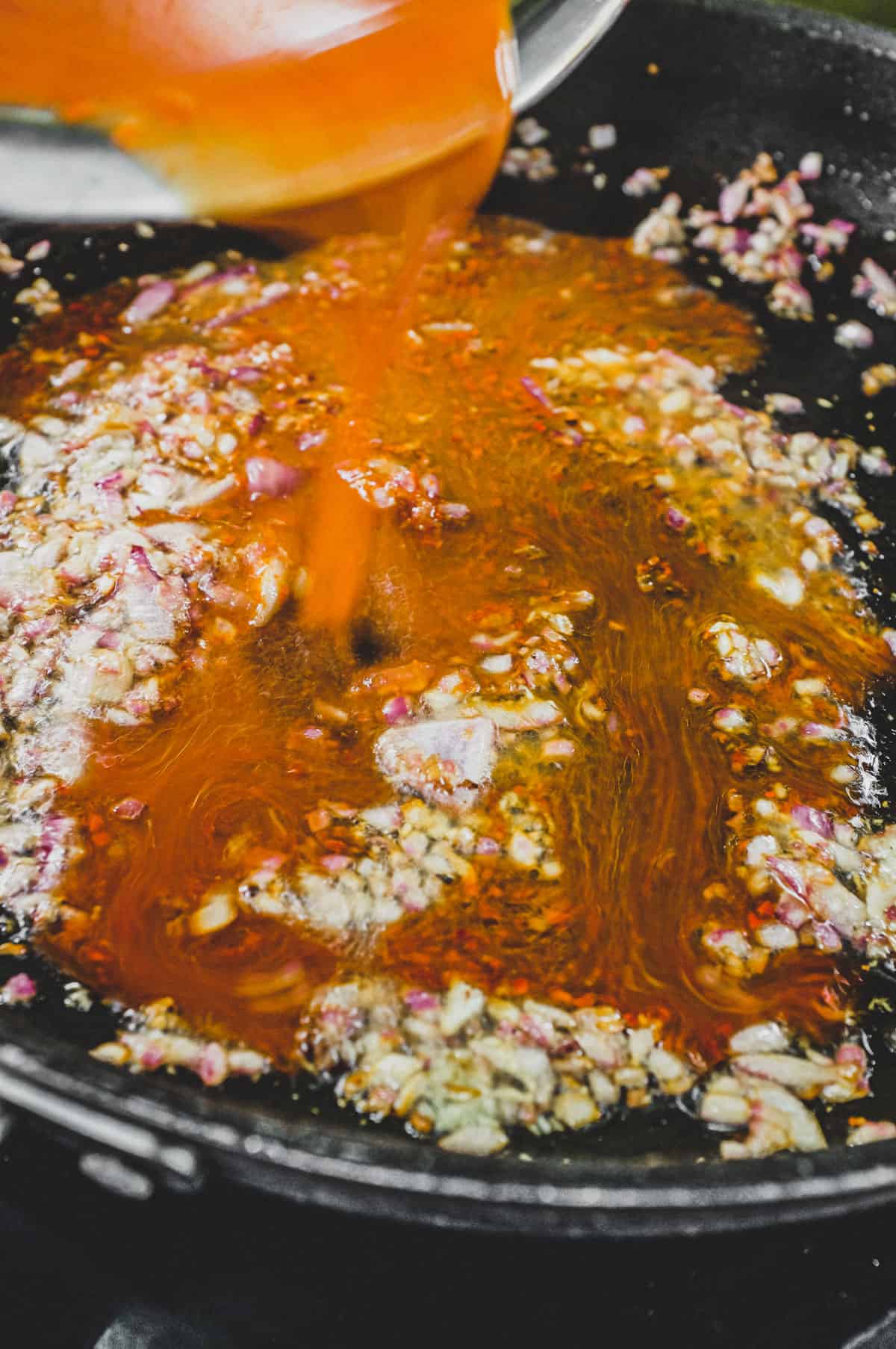
What type of tofu to choose - Pro tips.
Tofu can be a confusing affair, especially if you're at an Asian supermarket there's a world of options and if Chinese/Japanese or Korean aren't your first language it can be traumatic trying to pick the right one. Firm or extra-firm tofu is the type you should look out for in english. In other Asian languages look out for:
- Korean: "dubu" (두부) or "yuksoo dubu" (육수 두부).
- Chinese: "老豆腐" (lǎo dòufu) or "硬豆腐" (yìng dòufu).
- Japanese: "木綿豆腐" (momendofu) or "絹漉し豆腐" (kinugoshi dofu)
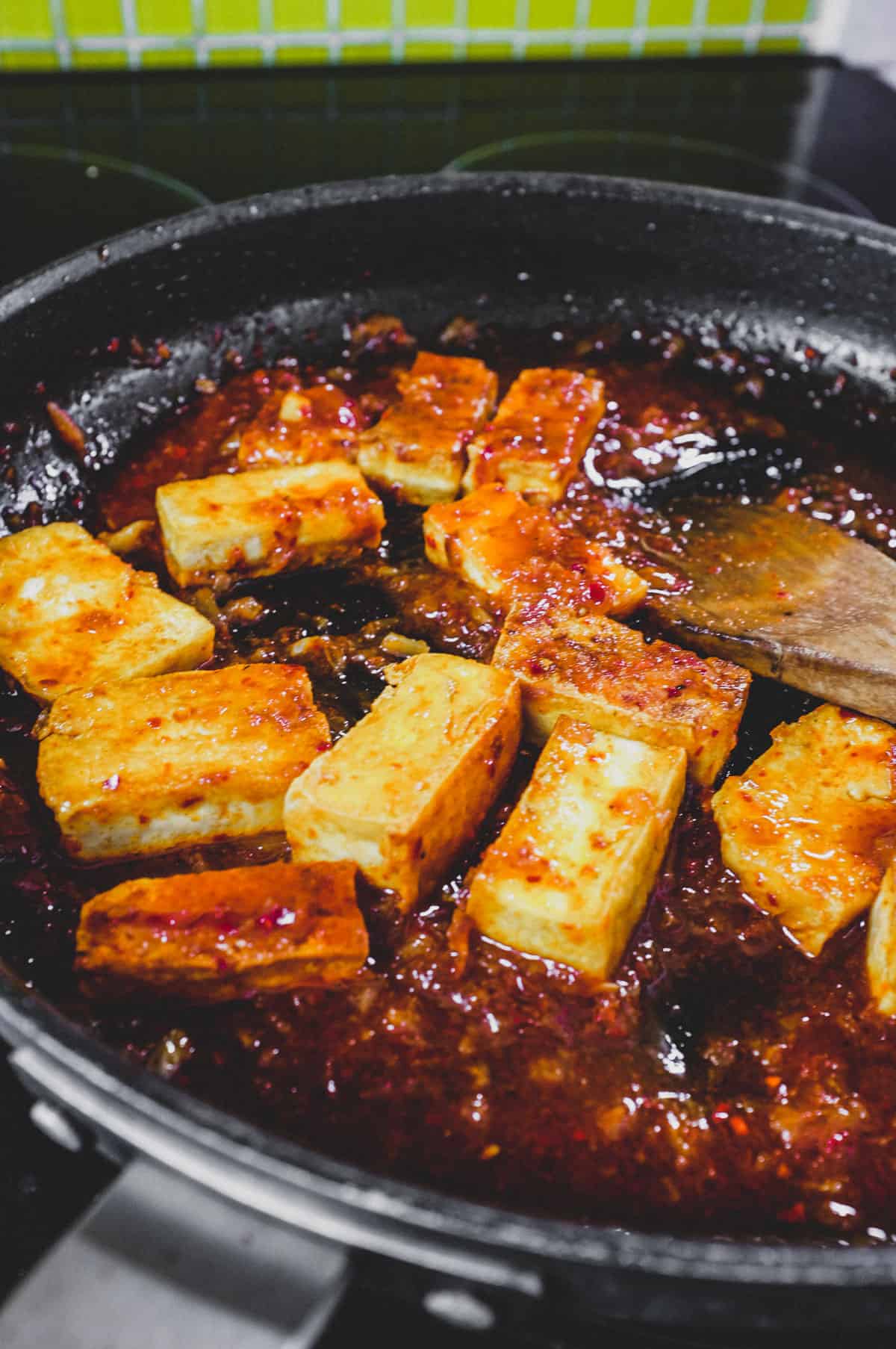
Serving & Storage Suggestions
Dubu-jorim can be served in various ways, depending on personal preference and the accompanying dishes. Here are some common serving suggestions:
- Over Rice: Serve Dubu-jorim over steamed rice for a simple and satisfying meal. The flavourful sauce from the dish pairs well with the plain rice.
- As a Side Dish (Banchan): Serve Dubu-jorim as part of a Korean meal alongside other banchan (side dishes) such as kimchi, namul (seasoned vegetables), and pickled radishes. It adds variety and depth to the overall dining experience.
- In a Rice Bowl (Bibimbap): Incorporate Dubu-jorim into bibimbap, a popular Korean rice dish topped with various seasoned vegetables, meat, egg, and gochujang (Korean chilli paste). The tofu adds protein and flavour to the ensemble.
- With Noodles: Serve Dubu-jorim alongside or mixed into noodles, such as japchae (stir-fried glass noodles) or naengmyeon (cold buckwheat noodles). The combination creates a hearty and flavourful noodle dish.
- As a Topping: Use Dubu-jorim as a topping for salads, wraps, or sandwiches for a vegetarian-friendly option with a punch of flavour and protein.
Ultimately, Dubu-jorim is versatile and can be enjoyed in various ways, so feel free to get creative and experiment with different serving ideas!
Storage
- Refrigerate - cooled Dubu-jorim in an airtight container for 3-4 days.
- Freeze - in a suitable container for up to 1-2 months.
- Reheat - gently on the stove or in the microwave before serving hot.
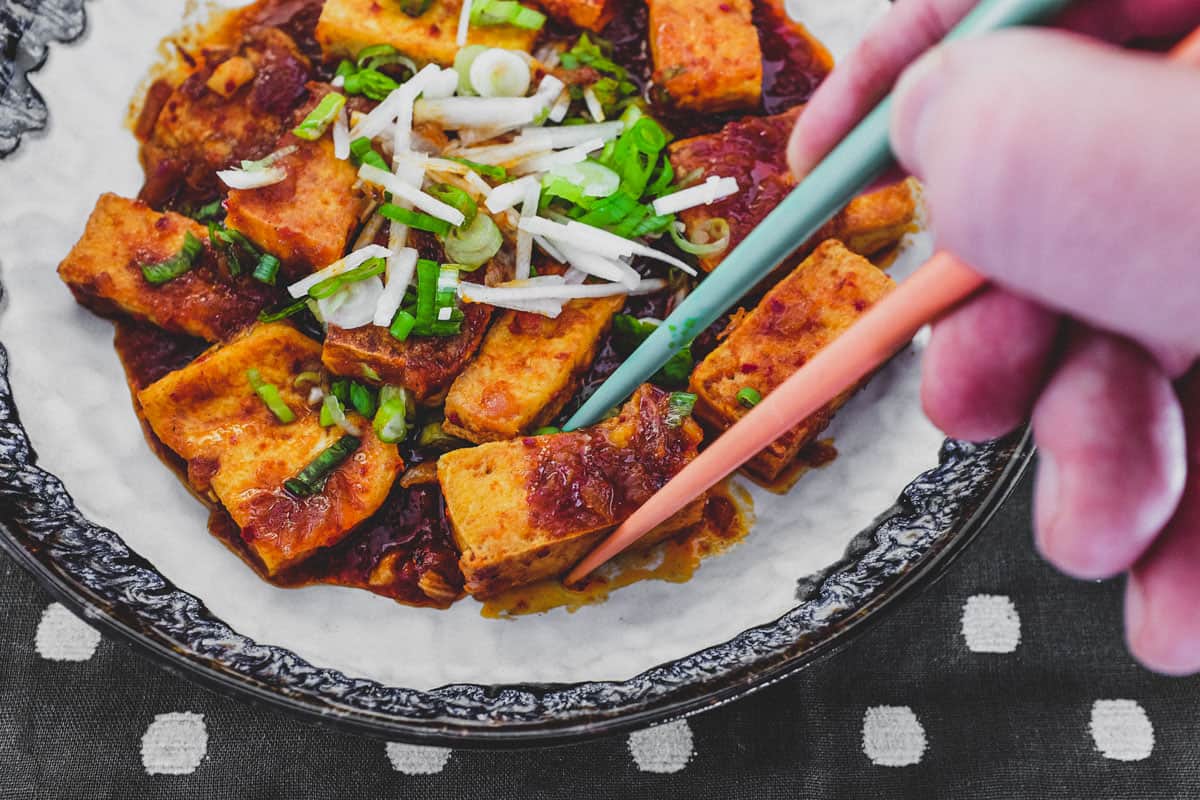
Ready to get cooking?
Whether served as a main course or a side dish, this versatile vegetarian recipe promises a satisfying culinary experience that celebrates the essence of Korean cuisine. It's a real winner for me at any time of the day and as a main or side dish. Packed with spicy, umami flavours it's a no-fail option every time. I hope you enjoy.
More Korean recipes
If you liked this recipe, then be sure to check out more of my Korean favourites.
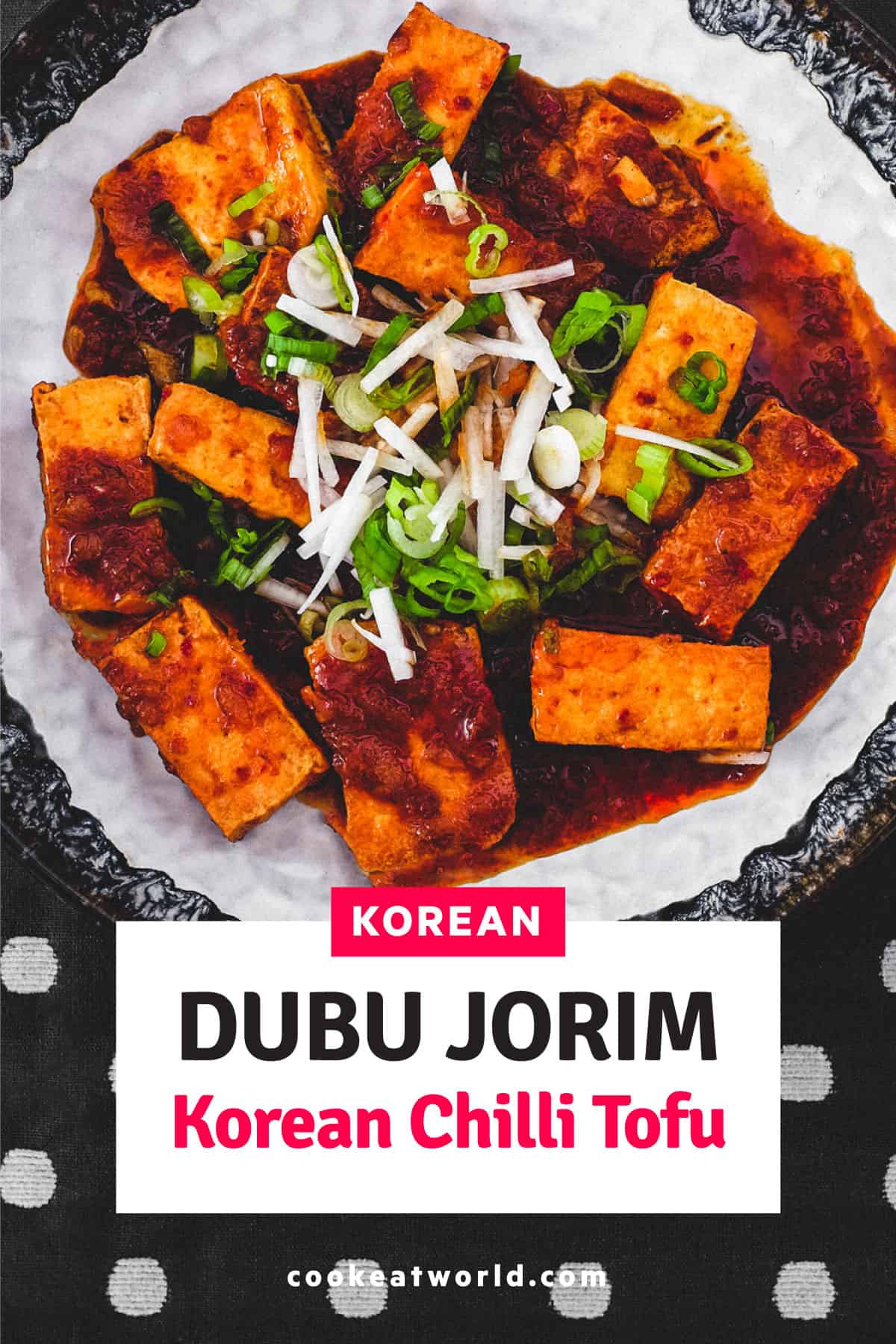
Any Questions? (FAQ)
Have a question about dubu-jorim? Let me know in the comments.
What ingredients are essential for Dubu Jorim?
Essential ingredients include firm tofu, soy sauce, garlic, sesame oil, sugar, and optional additions like green onions or chilli peppers.
Can I adjust the spice level of Dubu Jorim?
Yes, you can adjust the spice level by adding more or less chili peppers or chili flakes according to your preference.
How should I serve Dubu Jorim?
Serve Dubu Jorim as a main dish with steamed rice or as a side dish (banchan) in a Korean meal alongside other dishes like kimchi and vegetables. See above for a few more suggestions.
This recipe uses affiliations and may receive a commission based on your activity (link clicks). Learn more.
Ingredients
- 1 pack firm tofu (285g)
- 1 tbsp soy sauce
- 1 tbsp gochugaru (Korean chilli flakes)
- 3 tbsp gochujang sauce (or 1 tbsp gochujiang paste)
- ½ tsp salt
- 1 tsp sugar
- 1 garlic clove (minced)
- 3 tbsp canola oil
- ½ onion (medium) (finely diced)
- 1 tsp sesame oil
- 2 spring onions (green onions - thinly sliced)
- ½ cup daikon radish (thinly julienned)
Instructions
- Remove the tofu from the pack and pat dry on paper towels. Divide into around 12 pieces or into thick slices.
- Whisk together the soy sauce, salt, sugar, gochugaru, gochujiang with 3/4 cup water and set aside.
- Heat the oil in a large frying pan over a moderate heat until hot.
- Add the tofu and fry for abour 7 minutes each side until the tofu is crisp and brown. Remove with a slotted spoon and drain on paper towels.
- Pour off the oil until you have about 1 tbsp left, then add the diced onion to the pan. Let this cook for 4-5 minutes until the onion is soft and golden then add the garlic and fry briefly.
- Pour in the chilli sauce and let it come to a sizzle. Simmer for 2-3 minutes until it reduces a little - it should have consistency that sticks to the back of a spoon but not too thick.
- Return the tofu to the pan and let it sizzle for another minute. Remove from the heat. Drizzle over the sesame oil and stir well.
- Sprinkle over the spring onion and radish and serve either hot over rice or at room temperature as part of a larger 'banchan' (small plate) feast.
Notes
- Over Rice: Enjoy Dubu-jorim with steamed rice for a satisfying meal, complementing the plain rice with its flavoursome sauce.
- As a Side Dish (Banchan): Incorporate Dubu-jorim into a Korean spread alongside banchan like kimchi and namul, enhancing the dining experience.
- In a Rice Bowl (Bibimbap): Integrate Dubu-jorim into bibimbap, enriching the popular rice dish with protein and flavour.
- With Noodles: Pair Dubu-jorim with noodles such as japchae or naengmyeon for a hearty and flavourful noodle dish.
- As a Topping: Utilise Dubu-jorim as a topping for salads, wraps, or sandwiches, providing a vegetarian-friendly option packed with flavour and protein. Experiment and enjoy!
Storage:
For optimal storage of Dubu-jorim:- Store cooled Dubu-jorim in an airtight container in the refrigerator for 3-4 days.
- Freeze in a suitable container for longer-term storage, up to 1-2 months.
- Reheat gently on the stove or in the microwave before serving piping hot.



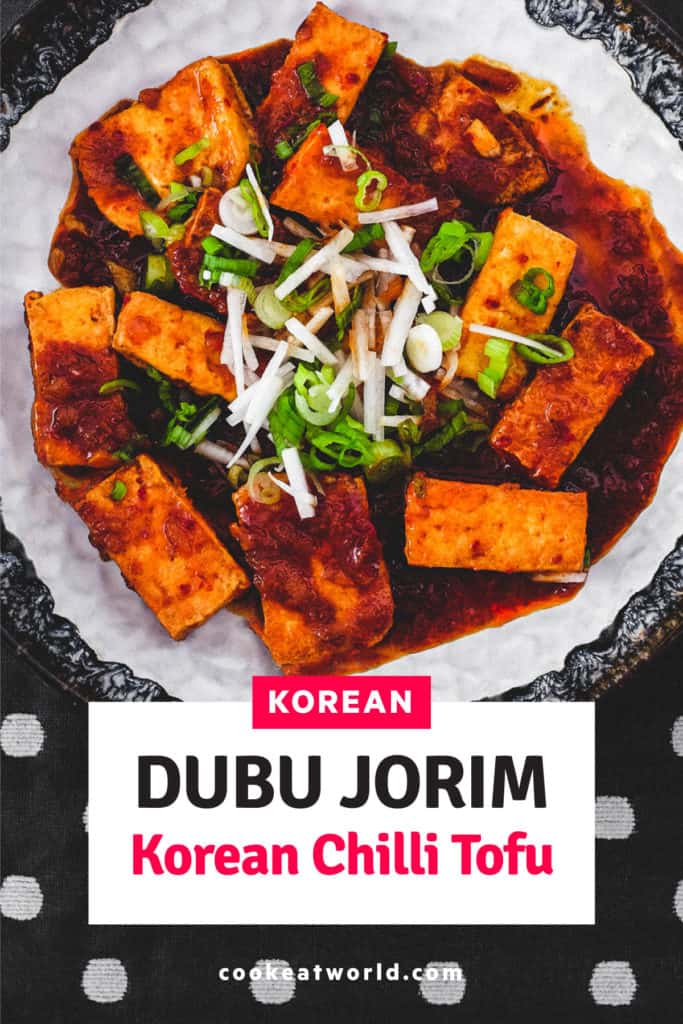
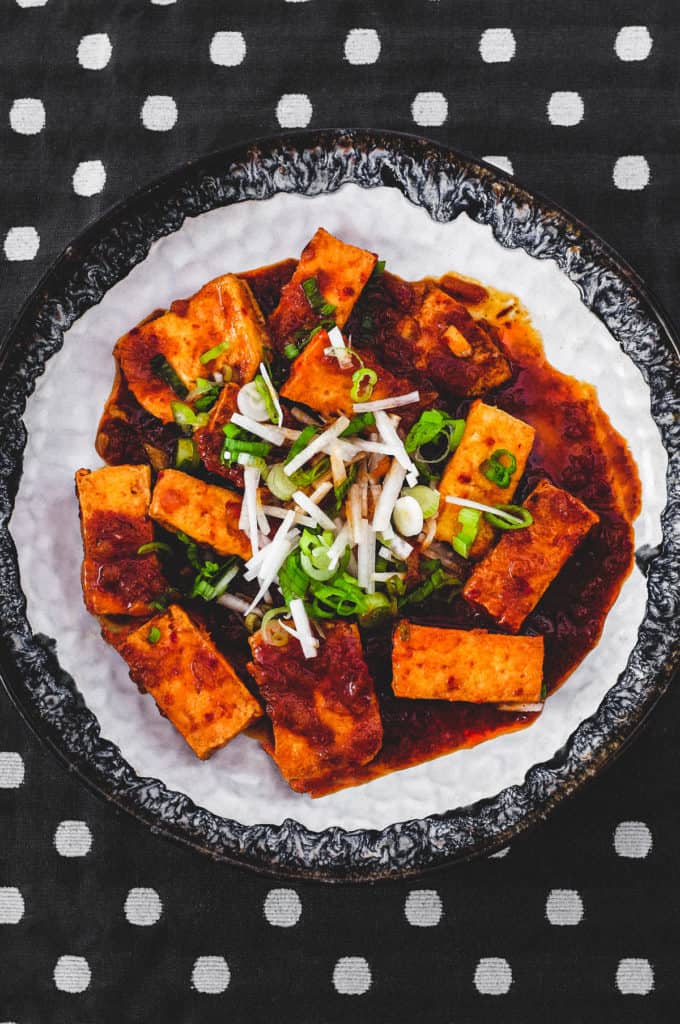
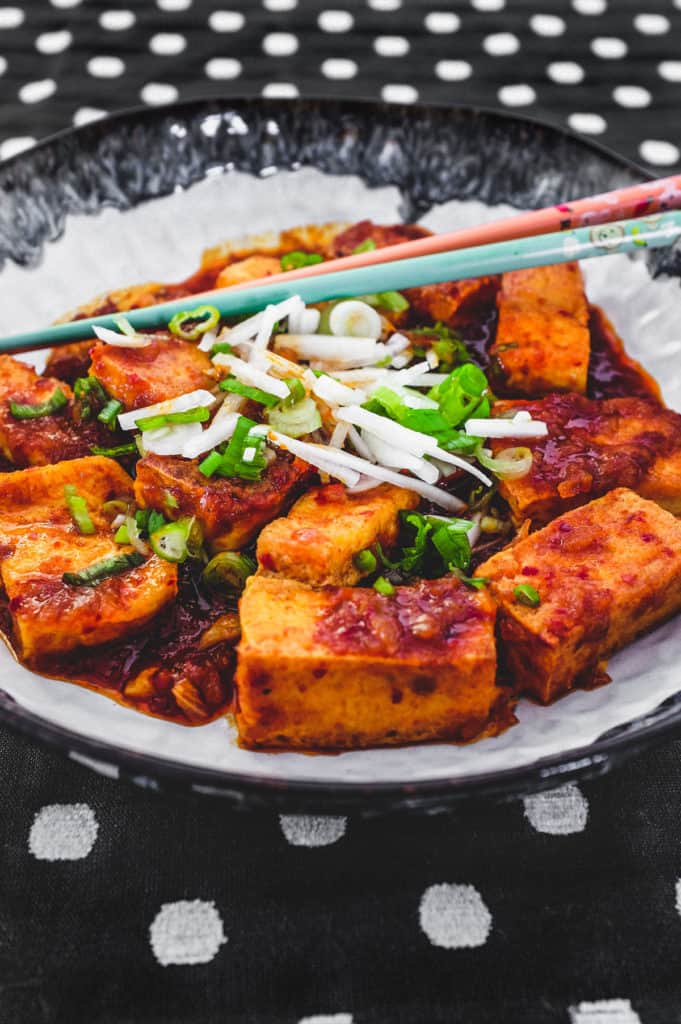

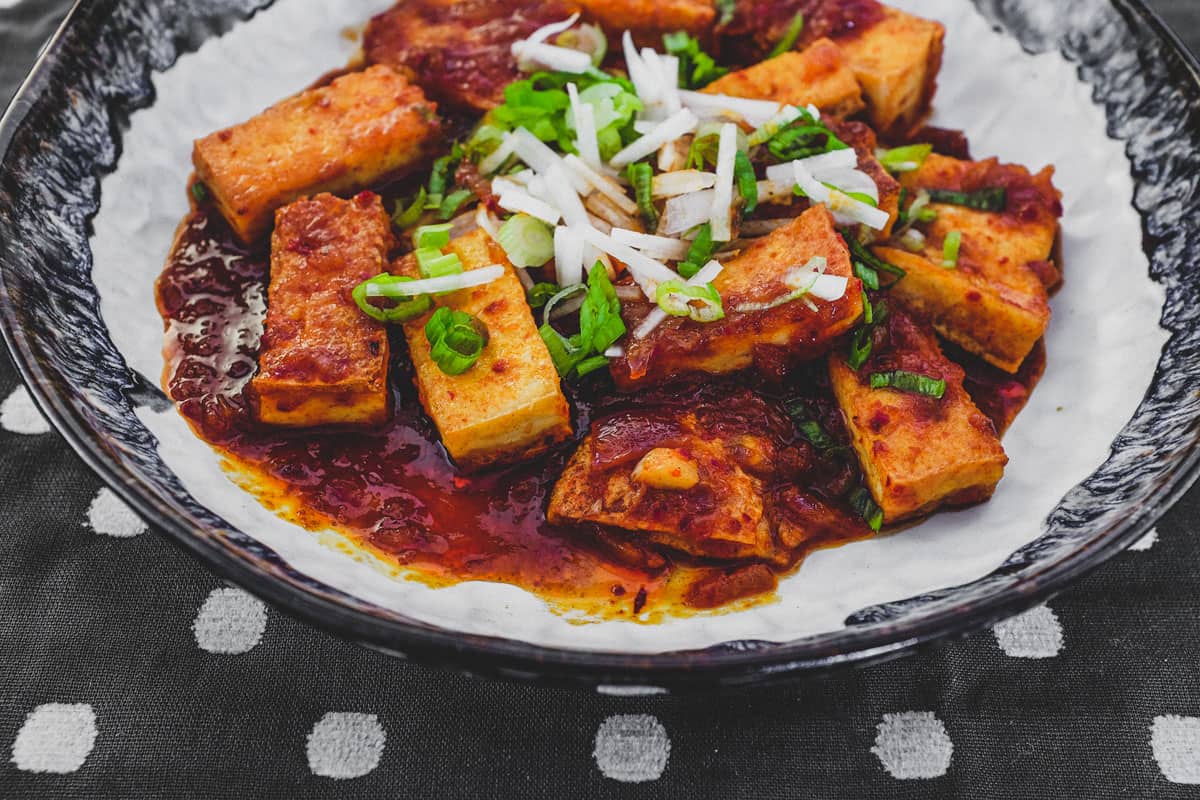

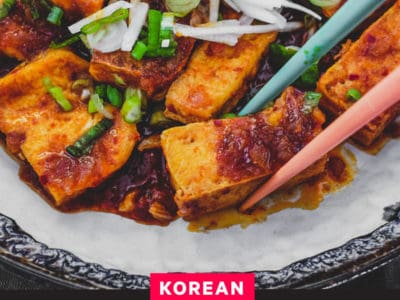



Leave A Comment